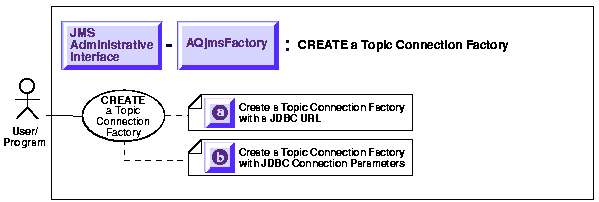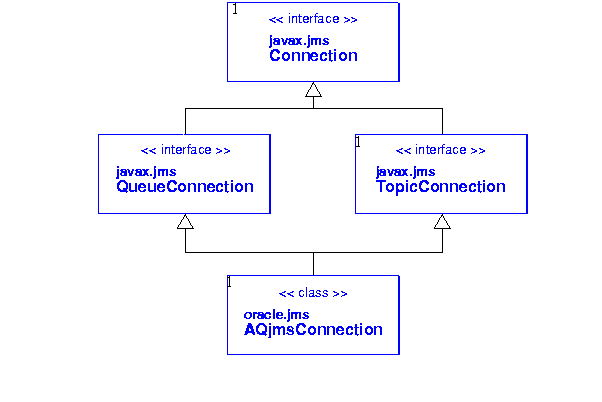Release 2 (8.1.6)
Part Number A76938-01
Library |
Product |
Contents |
Index |
| Oracle8i Application Developer's Guide - Advanced Queuing Release 2 (8.1.6) Part Number A76938-01 |
|
This Guide describes features of application development on the Oracle Server having to do with Oracle Advanced Queuing, Release 8.1.5. Information in this Guide applies to versions of the Oracle Server that run on all platforms, and does not include system-specific information.
The Preface includes the following sections:
Oracle Advanced Queueing (Oracle AQ) provides message queuing as an integrated part of the Oracle server. Oracle AQ provides this functionality by integrating the queuing system with the database, thereby creating a message-enabled database. By providing an integrated solution Oracle AQ frees application developers to devote their efforts to their specific business logic rather than having to construct a messaging infrastructure.
The Oracle8i Application Developer's Guide - Advanced Queuing is intended for programmers developing new applications that use Oracle Advanced Queuing, as well as those who have already implemented this technology and now wish to take advantage of new features.
The increasing importance of Oracle AQ has led to its being presented as an independent volume within the Oracle Application Developers documentation set.
For information about the differences between Oracle8 and the Oracle8 Enterprise Edition and the features and options that are available to you, see Getting to Know Oracle8i.
Use the PL/SQL User's Guide and Reference to learn PL/SQL and to get a complete description of this high-level programming language, which is Oracle Corporation's procedural extension to SQL.
The Oracle Call Interface (OCI) is described in:
You can use the OCI to build third-generation language (3GL) applications that access the Oracle Server.
Oracle Corporation also provides the Pro* series of precompilers, which allow you to embed SQL and PL/SQL in your application programs. If you write 3GL application programs in Ada, C, C++, COBOL, or FORTRAN that incorporate embedded SQL, refer to the corresponding precompiler manual. For example, if you program in C or C++, refer to the Pro*C/C++ Precompiler Programmer's Guide.
For SQL information, see the Oracle8i SQL Reference and Oracle8i Administrator's Guide. For basic Oracle concepts, see Oracle8i Concepts.
The Application Developer's Guide - Advanced Queuing contains the following chapters and appendices:
This chapter describes the requirements for optimal messaging systems. Although Oracle AQ is a relatively new technology, and not all these goals have been realized, you can get an overview of the design and a clear idea of the intended direction.
This chapter describes features already present in Oracle AQ under three headings: General Features, Enqueue Features, and Dequeue Features.
This chapter describes the elements you need to work with and issues you will want to take into consideration in preparing your AQ application environment.
This chapter discusses issues related to managing Advanced Queuing such as migrating queue tables (import-export), security, enterprise manager support, protocols, sample dba actions as preparation for working with AQ, and current restrictions.
This chapter discusses advanced topics.
Chapter 6, "Frequently Asked Questions"
Frequently asked questions are answered here.
Chapter 7, "Modeling and Design"
This chapter covers the fundamentals of Advanced Queueing modeling and design.
Chapter 8, "A Sample Application Using AQ"
This chapter considers the features of Oracle Advanced Queuing in the context of a sample application.
Chapter 9, "Administrative Interface"
This chapter describes the administrative interface to Oracle Advanced Queuing.
Chapter 10, "Administrative Interface: Views"
In this chapter we describe the administrative interface with respect to views in terms of a hybrid of use cases and state diagrams.
Chapter 11, "Operational Interface: Basic Operations"
In this chapter we describe the operational interface to Oracle Advanced Queuing in terms of use cases.
Chapter 12, "Creating Applications Using JMS"
In this chapter we consider the features of the Oracle JMS interface to AQ in the context of a sample application based on that scenario.
Chapter 13, "JMS Administrative Interface: Basic Operations"
In this chapter we describe the administrative interface to Oracle Advanced Queuing in terms of use cases.
Chapter 14, "JMS Operational Interface: Basic Operations (Point-to-Point)"
In this chapter we describe point to point operations.
Chapter 15, "JMS Operational Interface: Basic Operations (Publish-Subscribe)"
In this chapter we describe publish-subscribe operations.
Chapter 16, "JMS Operational Interface: Basic Operations (Shared Interfaces)"
In this chapter we describe shared interface operations.
Appendix A, "Oracle Advanced Queuing by Example"
This appendix provides examples of operations using different programatic environments
Appendix B, "Oracle JMS Interfaces, Classes and Exceptions"
This appendix provideds a list of Oracle JMS interfaces, classes & exceptions.
Appendix C, "Scripts for Implementing 'BooksOnLine'"
This appendix contains scripts used in the "BooksOnLine" example.
Appendix D, "JMS Error Messages"
A list of error messages is provided here to aid you in troubleshooting problems.
This manual makes use of the Universal Modeling Language (UML) as a way of explaining technology. A full presentation of the UML is beyond the scope of this documentation set, however we do provide a brief description of the subset of UML notation that we use in a chapter devoted to visual modelling inOracle8i Application Developer's Guide - Fundamentals. What follows here is a selection from that chapter of those elements that are used in this book.
The online (HTML and PDF) versions of these diagrams include active areas that either have blue perimeters or look like buttons. You can use these links to traverse the following relationships:
The following examples illustrate these relationships.
Graphic Element

|
|
Description
This Use Case Diagram combines a number of the elements: |
Graphic Element

|
|
Description
This Class Diagram has links to the individual class diagrams which form its components. This reduced view of the classes shows |
The following notational and text formatting conventions are used in this guide:
Square brackets indicate that the enclosed item is optional. Do not type the brackets.
Braces enclose items of which only one is required.
A vertical bar separates items within braces, and may also be used to indicate that multiple values are passed to a function parameter.
In code fragments, an ellipsis means that code not relevant to the discussion has been omitted.
SQL or C code examples are shown in monospaced font.
Italics are used for OCI parameters, OCI routines names, file names, and data fields.
Uppercase is used for SQL keywords, like SELECT or UPDATE.
This guide uses special text formatting to draw the reader's attention to some information. A paragraph that is indented and begins with a bold text label may have special meaning. The following paragraphs describe the different types of information that are flagged this way.
Note: The "Note" flag indicates that the reader should pay particular attention to the information to avoid a common problem or increase understanding of a concept.
Warning: An item marked as "Warning" indicates something that an OCI programmer must be careful to do or not do in order for an application to work correctly.
See Also: Text marked "See Also" points you to another section of this guide, or to other documentation, for additional information about the topic being discussed.
We value and appreciate your comment as an Oracle user and reader of our manuals. As we write, revise, and evaluate our documentation, your opinions are the most important feedback we receive.
You can send comments and suggestions about this manual to the following e-mail address:
If you prefer, you can send letters or faxes containing your comments to the following address:
|
|
 Copyright © 1996-2000, Oracle Corporation. All Rights Reserved. |
|